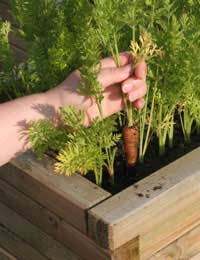
We all need to cut down on supermarket spending, so growing our own food has become more attractive than ever. Although it can be hard to plan a harvest that will feed the family all year round, there are many vegetables that can be grown from summer right through to winter. Here are some suggestions to get you started.
Organic Salad All Year Round
Salad is one of the most popular crops for first-time vegetable growers. It’s easy and fast, and if you have a good spot you can pick it for most of the year. In winter, you can pick Perpetual Spinach (leaf beet), Winter Radish, Chicory (Sugar Loaf), and Corn Salad (Lamb’s Lettuce). Sow Winter Density and Arctic King in late summer, and you’ll be eating it during February, March and April – when there’s not much else around.
Spinach, Chicory and Corn Salad are hardy, which means they’ll tolerate cold weather – but they won’t grow very much. So you want to sow them soon enough to allow them to do most of their growing during late summer and autumn. If you do have the space to sow some salads under protection (or on a sunny porch that won’t get frosty), this is even better. You will be able to grow salad leaves faster and for a longer period.
Salad Extras: Pak Choi, Fennel and Mooli
There are a few more vegetables worth mentioning for autumn-winter cropping. Pak Choi – a stir-fry favourite – can be sown in July and left in the ground for part of winter, as it will tolerate some frost. This delicious green vegetable has white stems that can be eaten like asparagus. Don’t sow sooner than July or it will bolt. Fennel is reasonably hardy and some varieties will tolerate a little frost – sow in late summer and you will be enjoying the bulbs in autumn. Mooli – Japanese radish – is another useful crop for late autumn. Sow after July and you will be harvesting it from September to November. There’s a wide variety of colours available: pink (Mantanghong), black (Black Spanish), white (Mino Early) and even green (Green Godess).
Year-Round Organic Vegetables: Kale, Chard and Carrots
There’s another category of vegetables that can be grown and enjoyed all year round. In the spring and early summer, chard and spinach are sown and cut as leaf crops. This just means that you cut them while the leaves are young, taking a few from each plant. If you want to grow them for winter too, delay sowing until August, and space the seeds further apart (about 20-30cm). Allow the kale and chard plants to keep growing (resist cutting the leaves) and you’ll have good-sized leafy plants that will stand through winter frosts. You can harvest them when you need them – these older leaves will require longer cooking but they’re a good source of iron and vitamins in the cold months.
For the earliest spring onions and carrots, you’ll need a cloche – miniature ‘polytunnels’ for this purpose are available quite cheaply on eBay and similar sites. The cloche simply keeps frost away from the young plants, giving you a few extra weeks of growth. This is a very eco-friendly way of growing, since you need no artificial heat – all the cloche does is protect your plants from the coldest frosts, effectively increasing your growing season. You could be cropping your eco-friendly carrots and spring onions from February onwards.
